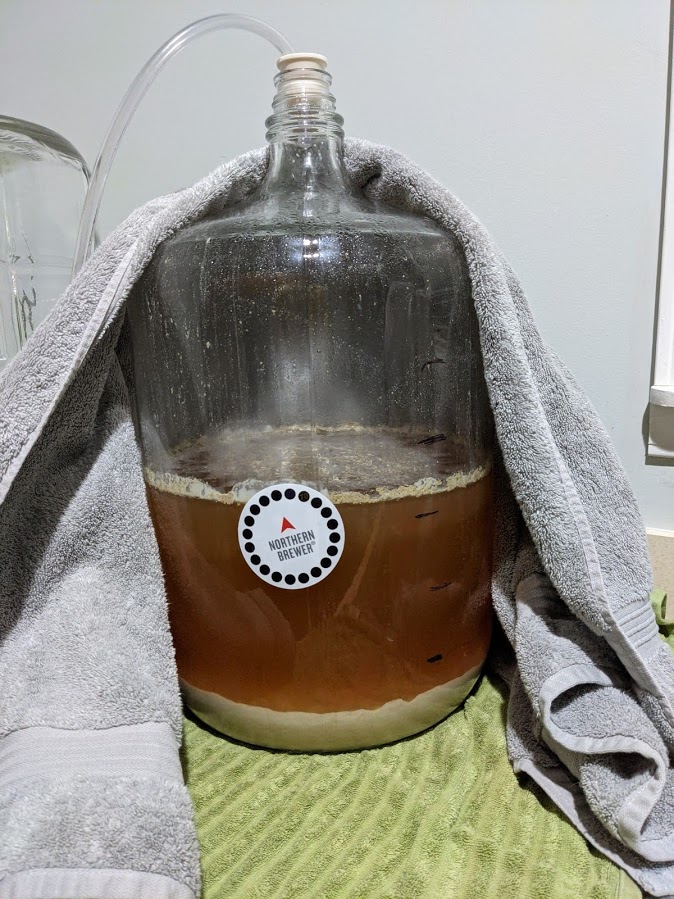shrews824
Well-Known Member
Ok guys/gals.
I had my first go this weekend with the BIAB method. All in all it went pretty well I thought. Couple of hiccups, but not anything that I don't think I can iron out with a few more attempts.
So, I brewed up a 3 gallon batch of an American Pale Ale:
6.0 lbs. of 2-Row
0.45 lbs. of Veinna
0.3 lbs. of Wheat
0.15 lbs. of Victory
0.06 lbs. of Special Roast
0.6 oz. of East Kent Goldings
0.6 oz. of Cascade
0.6 oz. of Citra
Safale S-05
Targets:
5.06 gallon of water
Strike water temp - 157F
Mash temp - 151
4.50 gallon of pre-boil wort
3.25 gallon of post boil wort
3.0 gallon into the fermenter
OG of 1.055
Boil recipe: 60 minutes
0.6 oz East Kent (60)
0.3 oz Cascade (30)
Whirfloc (15)
0.3 oz Cascade (10)
0.6 oz Citra (0)
Heating the strike water:
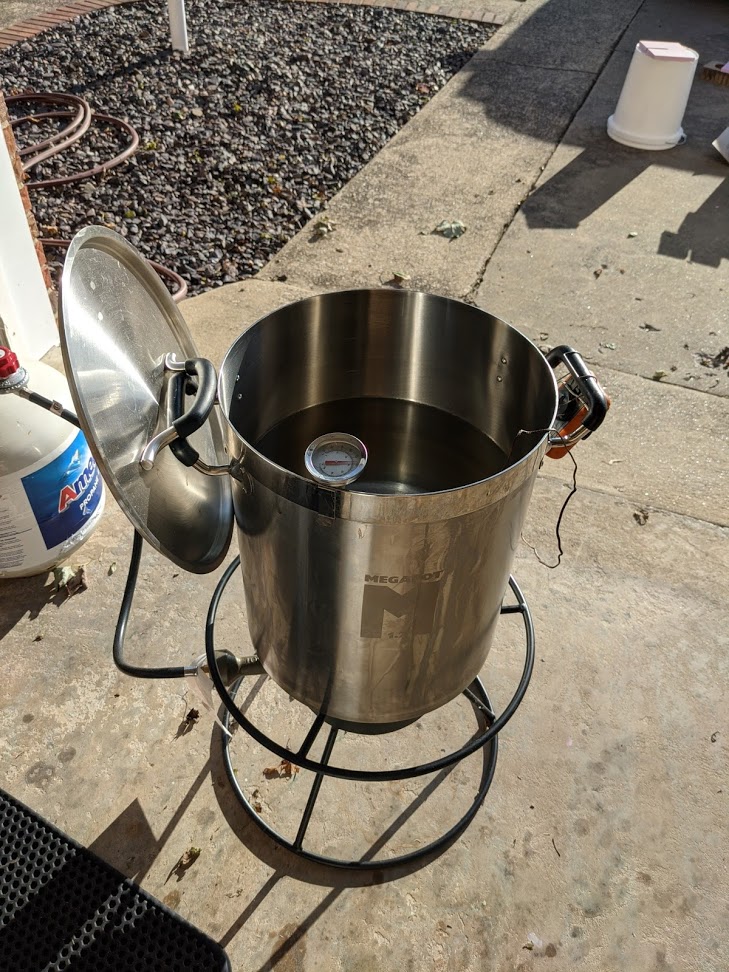
Not sure beings that this was my first all-grain, but this looked like it was double milled to me. It was pretty fine and found very few large chunks of grain.
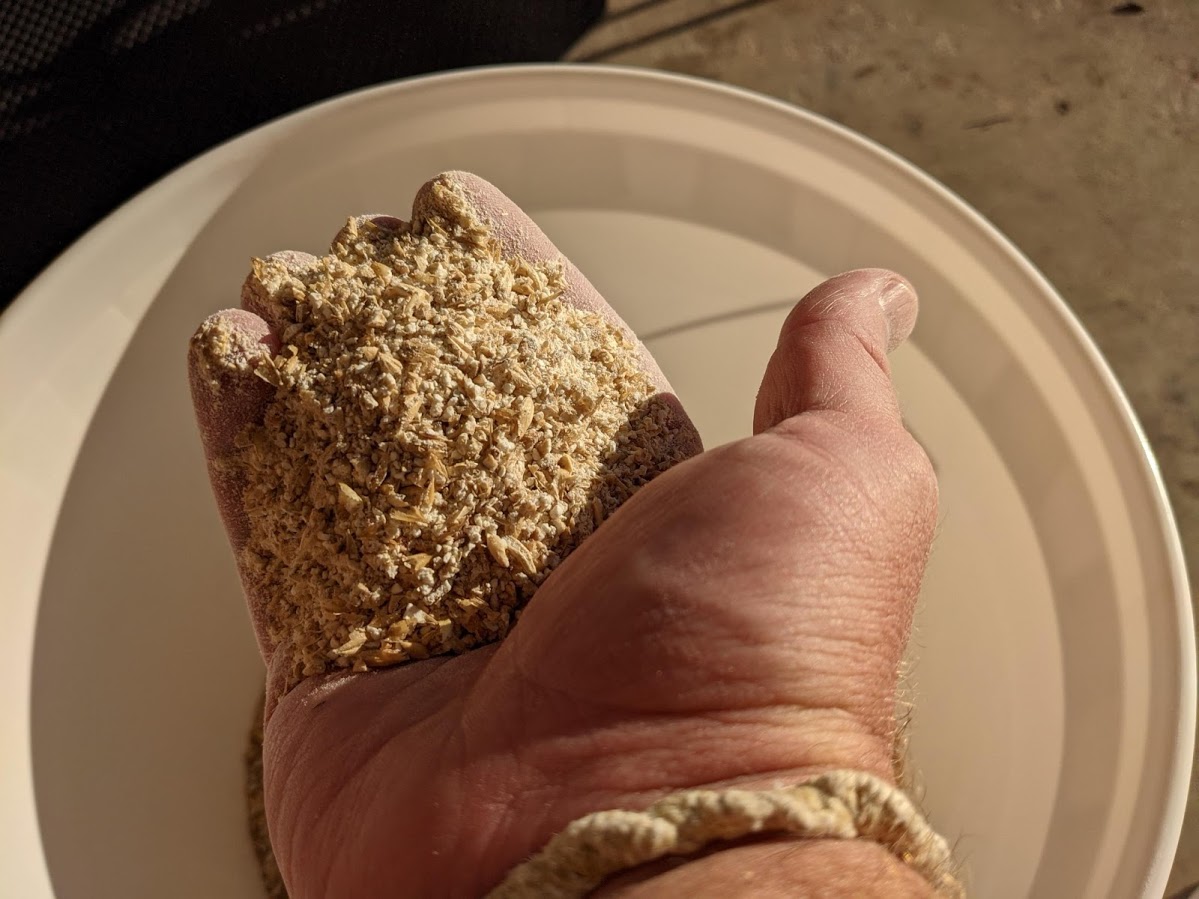
When mashing I used my probe thermometer that I use in my smoker. It worked great. After mashing my temp. showed 152F.

I used several of my fall and winter coats for insulations. I actually used my big, burly Carhart jacket and zipped it up around the actual kettle. I noticed the temp dropped to 148F after about 17-18 minutes. That was really concerning. So, I stripped all the coats off, turned on the burner and gave it a nice stir from the bottom and tried to work some of the mash up to the top. I had the burner going on low for about 2 minutes and I moved my thermometer probe around checking the temp. in several different places and noticed that the temp was rising quickly. Too quickly in fact. I immediately killed the heat and stirred once more and bundled everything back up. The temp was reading 154F. From that point on the mash temp never dropped below 151F for the remainder of the 60 minute mash. I think next time I will do a better job of checking all areas of the mash to see exactly what my temp is. I also do not think I thoroughly stirred well the first time and my heat distribution was not consistent.
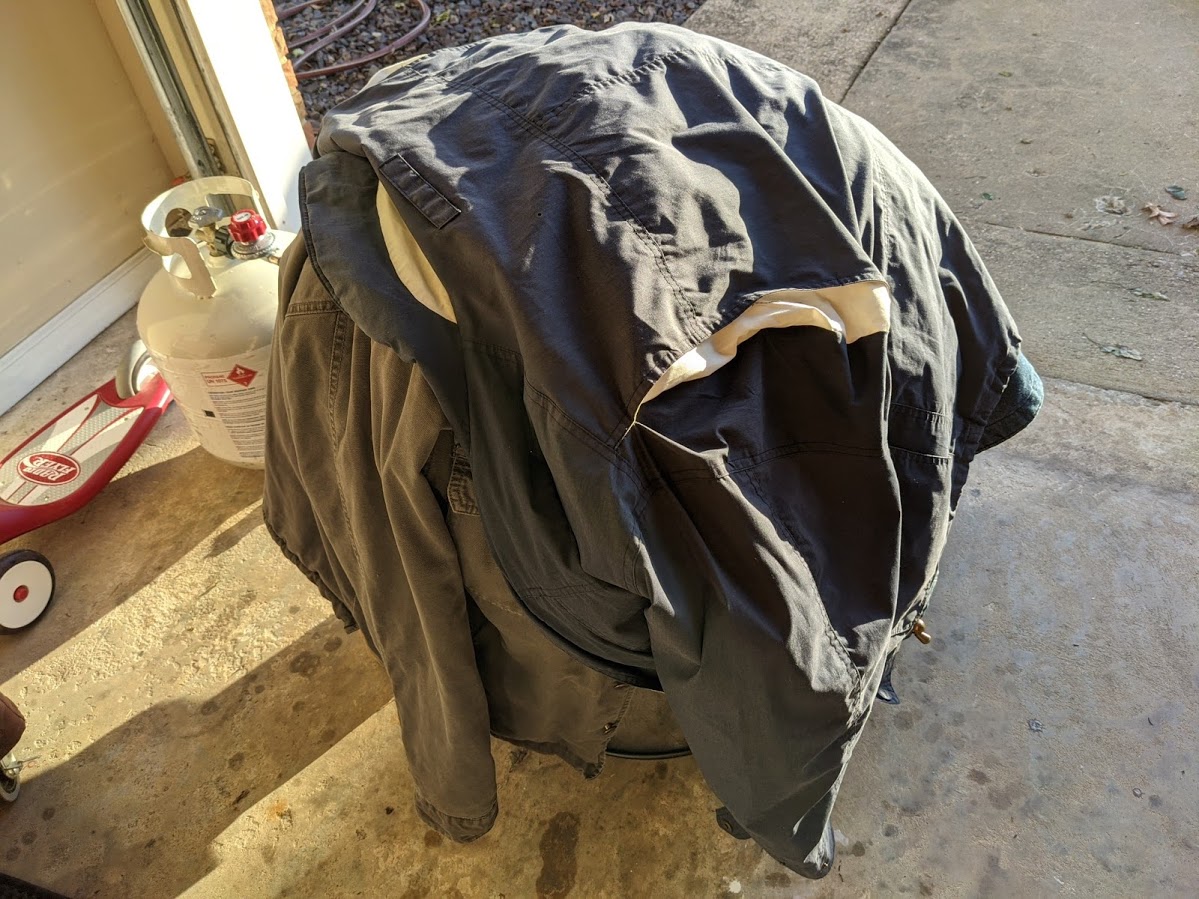
Just getting everything ready for the boil.

Finished the 60 minute mash. Everything looked and smelled wonderful I thought.
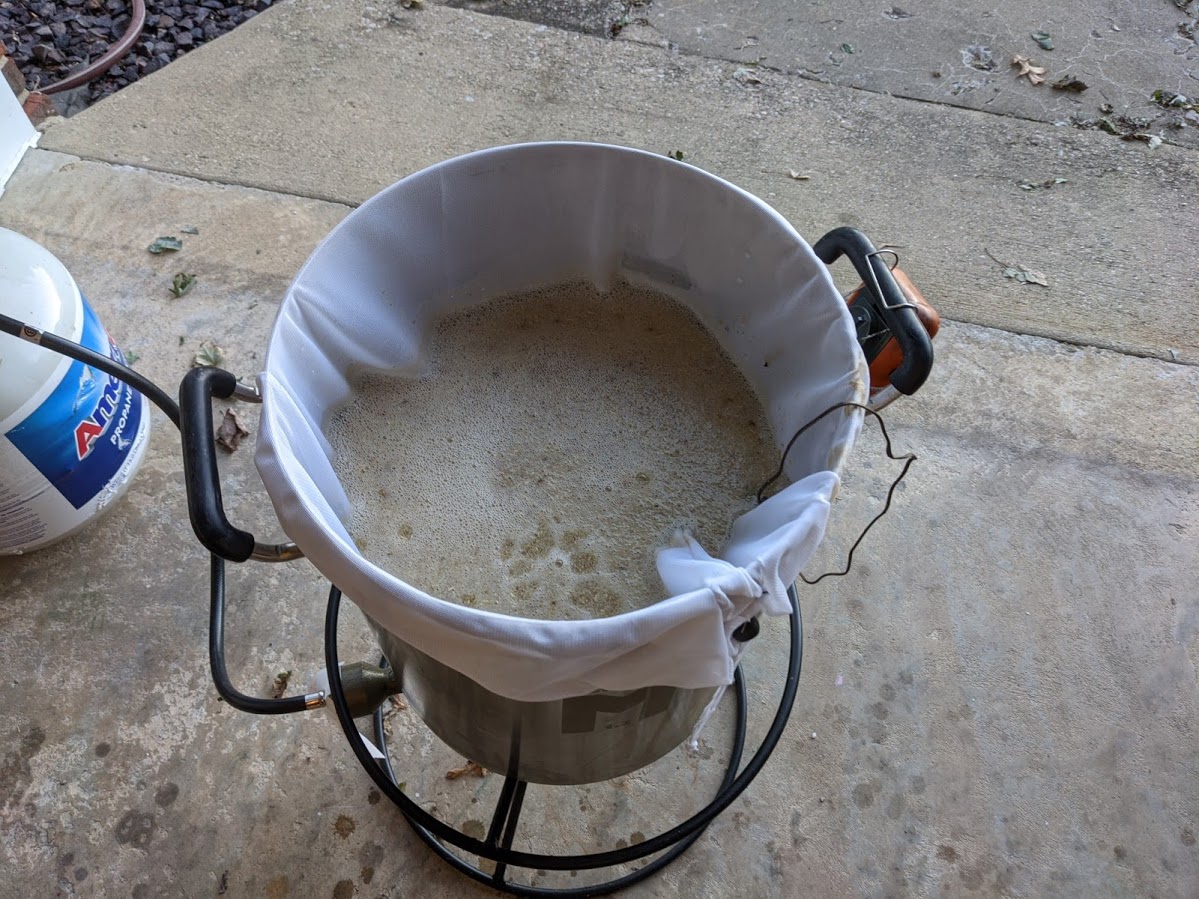
I let the bag drain for 5 minutes and then squeezed the crap out of it until I could barely get another drop. Note: Get a better colander. This plastic spaghetti colander was way too flimsy for the grain and absorption. It was teetering on totally collapsing. Total volume at this point was ~4.8/4.9 gallons pre-boil. Not quite as much absorption as I thought I might have.

Bringing to a rolling boil.
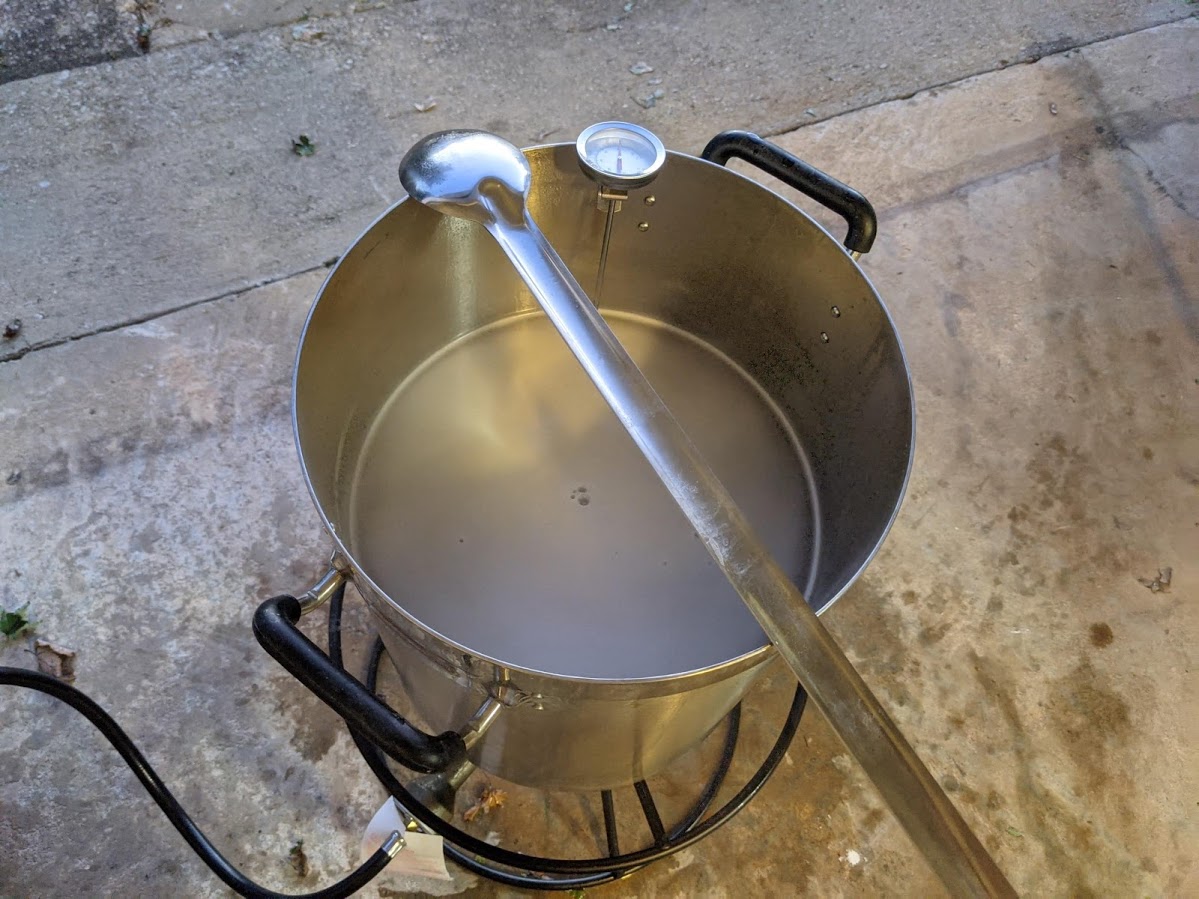
After the boil. With me stirring to help with cooling the chiller did its thing in about 15 minutes. Chilled to roughly 78F. About 3.8/3.9 gallons worth at this point. So, boiloff was about 1 gallon.

I let it set and settle in the fermenter overnight and pitched the yeast the next morning when it was at 70F. No starter. Just dry yeast and swirled it really well. It began showing bubbles after about 3 hours. It was going to town after about 24 hours and really getting after it. Looks healthy to me.
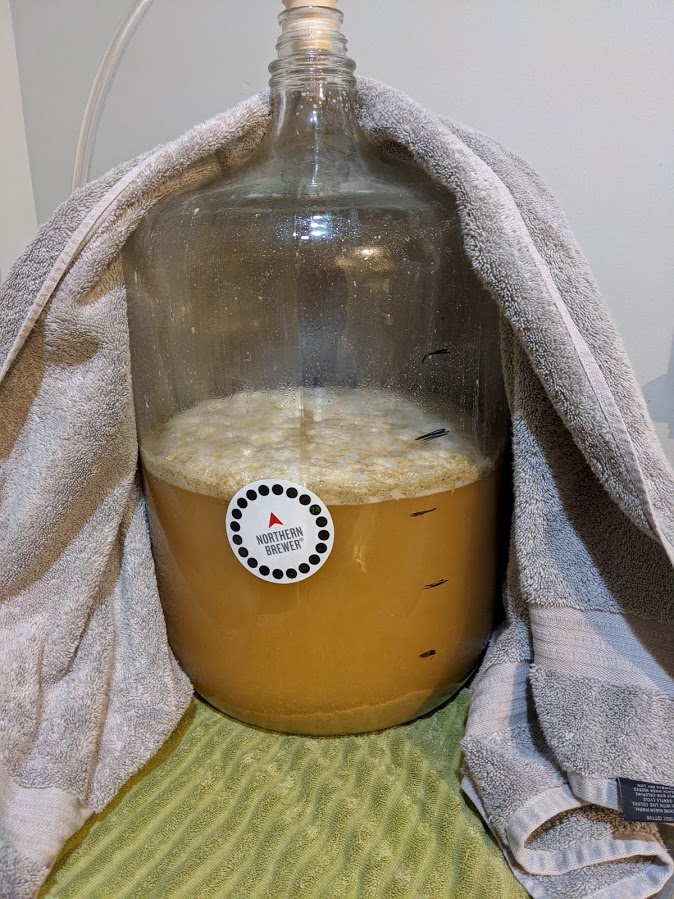
Ok. So, here was my major problem and maybe you guys can help me out. When I transferred to the fermenter I had a real problem keeping my sediment out of the fermenter. Never have I had a problem like this before. I usually get some, but nothing like this. I let it set for a while, but I still couldn't separate the liquid from the particles. No joke, I probably had about a gallon of sediment. I poured as slowly and gently as possible, but was still getting way too much. I thought my stirring as it cooled with the chiller would help in whirlpooling, but I guess I didn't do it correctly or something. Next time I think I'm just going to use my siphon and transfer that way or get some type of mesh screen or bag and try transferring.
All in all, it was a great brew day and things went pretty well. I'm guessing I'll get about 2.5 gallons of brew. I'm sure my efficiency is way off too, but that's ok for my first one I guess.
Oh, almost forgot. Went to take my OG reading and my hydrometer snapped and broke!!! I've ordered a new one and it should be here today. I save 250 mL of wort and am going to check it as soon as it arrives.
Can't wait to give it another go this coming weekend. I'm thinking I might try an American Porter.
Any feedback and criticism is welcome. Cheers!!!
Scott
I had my first go this weekend with the BIAB method. All in all it went pretty well I thought. Couple of hiccups, but not anything that I don't think I can iron out with a few more attempts.
So, I brewed up a 3 gallon batch of an American Pale Ale:
6.0 lbs. of 2-Row
0.45 lbs. of Veinna
0.3 lbs. of Wheat
0.15 lbs. of Victory
0.06 lbs. of Special Roast
0.6 oz. of East Kent Goldings
0.6 oz. of Cascade
0.6 oz. of Citra
Safale S-05
Targets:
5.06 gallon of water
Strike water temp - 157F
Mash temp - 151
4.50 gallon of pre-boil wort
3.25 gallon of post boil wort
3.0 gallon into the fermenter
OG of 1.055
Boil recipe: 60 minutes
0.6 oz East Kent (60)
0.3 oz Cascade (30)
Whirfloc (15)
0.3 oz Cascade (10)
0.6 oz Citra (0)
Heating the strike water:

Not sure beings that this was my first all-grain, but this looked like it was double milled to me. It was pretty fine and found very few large chunks of grain.

When mashing I used my probe thermometer that I use in my smoker. It worked great. After mashing my temp. showed 152F.

I used several of my fall and winter coats for insulations. I actually used my big, burly Carhart jacket and zipped it up around the actual kettle. I noticed the temp dropped to 148F after about 17-18 minutes. That was really concerning. So, I stripped all the coats off, turned on the burner and gave it a nice stir from the bottom and tried to work some of the mash up to the top. I had the burner going on low for about 2 minutes and I moved my thermometer probe around checking the temp. in several different places and noticed that the temp was rising quickly. Too quickly in fact. I immediately killed the heat and stirred once more and bundled everything back up. The temp was reading 154F. From that point on the mash temp never dropped below 151F for the remainder of the 60 minute mash. I think next time I will do a better job of checking all areas of the mash to see exactly what my temp is. I also do not think I thoroughly stirred well the first time and my heat distribution was not consistent.

Just getting everything ready for the boil.

Finished the 60 minute mash. Everything looked and smelled wonderful I thought.

I let the bag drain for 5 minutes and then squeezed the crap out of it until I could barely get another drop. Note: Get a better colander. This plastic spaghetti colander was way too flimsy for the grain and absorption. It was teetering on totally collapsing. Total volume at this point was ~4.8/4.9 gallons pre-boil. Not quite as much absorption as I thought I might have.

Bringing to a rolling boil.

After the boil. With me stirring to help with cooling the chiller did its thing in about 15 minutes. Chilled to roughly 78F. About 3.8/3.9 gallons worth at this point. So, boiloff was about 1 gallon.

I let it set and settle in the fermenter overnight and pitched the yeast the next morning when it was at 70F. No starter. Just dry yeast and swirled it really well. It began showing bubbles after about 3 hours. It was going to town after about 24 hours and really getting after it. Looks healthy to me.

Ok. So, here was my major problem and maybe you guys can help me out. When I transferred to the fermenter I had a real problem keeping my sediment out of the fermenter. Never have I had a problem like this before. I usually get some, but nothing like this. I let it set for a while, but I still couldn't separate the liquid from the particles. No joke, I probably had about a gallon of sediment. I poured as slowly and gently as possible, but was still getting way too much. I thought my stirring as it cooled with the chiller would help in whirlpooling, but I guess I didn't do it correctly or something. Next time I think I'm just going to use my siphon and transfer that way or get some type of mesh screen or bag and try transferring.
All in all, it was a great brew day and things went pretty well. I'm guessing I'll get about 2.5 gallons of brew. I'm sure my efficiency is way off too, but that's ok for my first one I guess.
Oh, almost forgot. Went to take my OG reading and my hydrometer snapped and broke!!! I've ordered a new one and it should be here today. I save 250 mL of wort and am going to check it as soon as it arrives.
Can't wait to give it another go this coming weekend. I'm thinking I might try an American Porter.
Any feedback and criticism is welcome. Cheers!!!
Scott
Last edited:





























![Craft A Brew - Safale S-04 Dry Yeast - Fermentis - English Ale Dry Yeast - For English and American Ales and Hard Apple Ciders - Ingredients for Home Brewing - Beer Making Supplies - [1 Pack]](https://m.media-amazon.com/images/I/41fVGNh6JfL._SL500_.jpg)

































